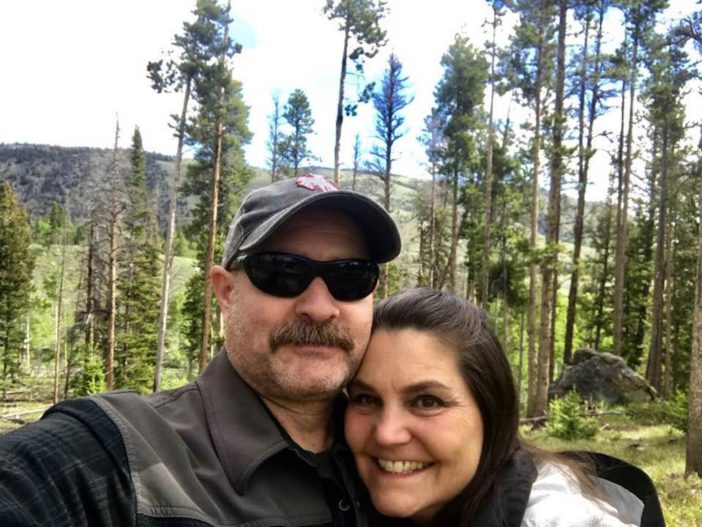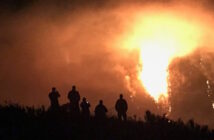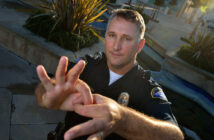Anaheim PD Sgt. Daron Wyatt and his wife, Misty, were cruising down the highway in their Subaru Outback, towing a 12-foot U-Haul trailer.
They were heading home Monday, Aug. 19 after spending nearly two weeks on their ranch in Laramie, Wyoming.
They arrived in Orange County on Wednesday, Aug. 21 – happy and rested, and looking forward to Dec. 30, when Wyatt will retire after a 33-year career in law enforcement.
He and his wife then will move to their 41-acre spread on Lake Hattie at the base of the Medicine Bow National Forest in the Snowy Mountain Range, elevation 7,500 feet.
Their summer trip – and Wyatt’s looming retirement — could have turned out quite differently if, on Aug. 1, an Orange County jury had returned with a different verdict in a civil case against Wyatt concerning the fatal shooting of a suspect.
For nearly a decade, the case dragged on in state and federal court.
But on Aug. 1, 2019, a jury in Santa Ana, ruling on a case that also named the City of Anaheim, determined that Wyatt did not use excessive or unreasonable deadly force, and was not negligent, in the fatal shooting on Sept. 25, 2009.
Below, Wyatt provides a detailed explanation of the legal odyssey he feared could have tainted his legacy as a police officer had the verdict gone against him and the city.
“I never second-guessed what happened that night,” Wyatt said of the shooting. “I knew that I did what I had to do to go home to my wife and kids.
“I think the public sometimes thinks cops go to work every day wanting to get involved in a shooting, and that’s just not the case. It’s something that is traumatic for us and our families.”
On their 18-hour drive back to Orange County, as they listened to ’80s music and vintage hard rock on “Hair Nation” on SiriusXM Radio, Wyatt and his wife felt relief and gratitude that his name has been cleared.
The civil lawsuit and ensuing court battles cast a dark cloud over a career distinguished by Wyatt’s fervent desire to seek justice for victims. In just one example, the Oxygen Network recently showcased Wyatt’s work in solving a notorious cold-case murder, the 1994 slaying of Cal State Fullerton student Cathy Torres.
The OIS (officer involved shooting) that tied up Wyatt and the City of Anaheim in court for nearly a decade happened after Wyatt had been an APD officer for only 14 months. He transferred to the APD from the Placentia PD after 13 years there, 10 as a sergeant, in addition to eight years at a few other Southern California police departments.
As Wyatt describes in detail below, the shooting changed him forever, both professionally and personally. He suffered a debilitating back injury that has resulted in chronic pain that will last the rest of his life.
He also temporarily lost some of his fighting spirit as a cop.
“I was a go-getter street cop who would go out and look to take bad guys to jail,” Wyatt said. “But because of this case, I thought twice before every contact, wondering if it could somehow land me in civil court again.”
Wyatt said he obviously felt relief when the verdict was read.
“To have this hang over my head as long as it did was very stressful,” he says. “It was just like a weight had been lifted off my shoulders. It was like, wow. It’s finally done. It’s finally done.”
The Wyatts have a 21-year-old daughter who is a senior studying pre-med at Colorado State University and an 18-year-old son who is a senior at a local high school.
“I didn’t want this to affect my husband’s retirement,” Misty says of the civil lawsuit. “He has a servant’s heart. Sitting in a courtroom and having them (plaintiff’s attorney) basically persecute your husband day in day out, it was just rough.”
Their thoughts now are focusing more and more on Misty Moments, the name of the ranch where their home is being built
In retirement, Wyatt plans to get more involved in photography, his longtime hobby.
“I’m also thinking about writing a book about some of my cases and what they’ve meant to me,” he says. “We may get horses and livestock. Misty wants chicken for eggs and a cow for milk.”
Here’s is Wyatt’s account of the shooting and the long legal process that followed:
Journey for justice
By Sgt. Daron Wyatt
On Aug. 1, 2019, at approximately 11:45 a.m., in Department C15 of the Orange County Superior Court, a jury returned a verdict in the case of F.E.V. v City of Anaheim and Daron Wyatt.
The jury voted 10-2 in our favor, deciding I did NOT use excessive or unreasonable deadly force and I was NOT negligent in the fatal shooting of Adolph Anthony Sanchez Gonzalez on Sept. 25, 2009. The jury’s decision capped a 10-year odyssey that caused untold stress on my family and me and completely changed me personally and professionally.
Here are the facts:
Proactive policing
Just after 2 a.m. on Sept. 25, 2009, my partner, Officer Matt Ellis and I were responding to a check-the-welfare call of a subject sleeping in the center divider of a busy street.
While en route, a minivan cut us off and almost hit us as it turned into a gas station. We considered stopping the van immediately, but decided to continue on to our call about two blocks away.
Our decision was guided by a couple of factors:
- The check-the-welfare call had a potential life safety issue should the subject roll into traffic and be hit by a car, and
- Beat integrity, meaning we didn’t want another unit to have to handle a call in our area.
Being proactive cops, I had entered the van’s license plate into our MDT (Mobile Data Terminal) when we first saw the van. We continued to the call and found the sprinklers were on in the center divider and the subject had moved on his way. We decided to head back to the gas station and see if the van was still there. While on our way, the return on the license plate popped up on the computer screen. The return included a prior contact in Anaheim where the van was involved in an arrest for possession of methamphetamine about a year earlier.
The van was still at the gas station and a lone male was standing outside. He was a male Hispanic with a shaved head and wearing loose baggy clothing. As I read the prior arrest report, I recognized the name of the arrestee as a subject I had dealt with several times when I worked Special Enforcement (Gangs and Narcotics) at a neighboring agency. Remember, in 2009, possession of methamphetamine was still a felony in California.
So, Matt and I parked around the corner where we could watch the van and follow it when it left. We wanted to see if we could observe more driving that would assist in determining if the driver was potentially impaired by alcohol and/or drugs.
Within a minute or two, the van left the gas station and we followed. The van was weaving within its lane. It made a right turn and we decided to initiate a stop. Matt activated the emergency lights and we both shined our spotlights into the rear windows.
The van kept driving a little longer than we thought reasonable, but didn’t seem to be trying to evade. The driver then made a wide, sweeping right-hand turn onto a small residential side street. As he did, he almost struck the opposite curb before swinging onto the right side of the street and yielding at the right curb. I could see through the rear window the driver was steering with his left hand, while he reached toward the back seat with his right hand.
A stop goes bad
When we stopped, I was out of the car quickly and started approaching on the sidewalk on the passenger side. I could see that not only was the driver still reaching back with his right hand, but he was looking over his left shoulder as if he was looking for an officer to approach on the driver’s side. The hair on the back of my neck stood up and I immediately drew down on him, and yelled something to the effect of, “If you reach down there again, I’m going to shoot you!”
I saw the driver’s hand move up toward his lap and heard Matt at the driver’s window tell the driver to turn the car off and then I heard him say several times, “Open your hand. Show me your hands.”
I moved up to the front passenger window. I could now see the driver’s right hand was clinched in a fist in his lap and he was reaching down with his left hand between the driver’s seat and the driver’s door panel.
Not good, right?
The driver never verbalized anything and looked back and forth between Matt and I, while clinching his jaw, refusing to open his right hand, and reaching around with his left hand. I saw that both the driver and front passenger windows were down about halfway and I watched as Matt tried to open the driver’s door, but couldn’t. I reached through the passenger window and tried to unlock the door. The lock went up and immediately back down. I couldn’t tell if I hadn’t gotten the lock up far enough or if the driver hit the automatic lock button. I tried again and was able to unlock the front passenger door.
I opened the passenger door and the driver continued to display pre-assaultive indicators by looking back and forth between Matt and I, refusing to obey commands, and not verbalizing anything. The driver was a big guy (6 feet tall and 253 pounds at autopsy) and had gang tattoos across his knuckles.
I reached in with my MagLite, struck him across the right elbow, and ordered him to open his hand. This happened three times without any response or compliance. The driver suddenly moved his right hand up to his mouth and threw something, presumably drugs, into his mouth.
An important fact was that when I first opened the passenger door, a bottle rolled out into the gutter.
Hold that thought….

A crime scene photo showing the starting location of the incident. Note the skid mark in the street and the bottle in the gutter. Photo courtesy of Anaheim City Attorney’s Office
I saw Matt reach through the driver’s window with both arms. From my viewpoint it looked like he was attempting a carotid restraint, but according to Matt’s statement, he was merely trying to control the driver’s arms and prevent him from swallowing the dope.
In any event, it looked like the driver was striking toward Matt’s face with his hands and fists. I immediately called for Code 3 assistance and started to go to the driver’s side to help Matt, but realized Matt was braced up against the driver’s door with both arms through the window, restricting me from being able to help from the driver’s side.
I went back to the open front passenger door and realized that due to the fact Matt had the driver pulled towards the driver’s window, I could no longer reach him from outside the van. My sole focus was on helping my partner, who from my viewpoint was physically fighting with the driver. Therefore, I knelt on the front passenger seat and punched the driver in the face and head five or six times while yelling at him to stop fighting.
Here’s where things went south in a real hurry.
I saw the driver reach with his right hand and slam the car into drive while simultaneously stomping on the gas pedal. The tires squealed and the car lurched forward, slamming the passenger door shut with me trapped inside. The van accelerated rapidly northbound on this small residential street and about 600 feet ahead was a T-intersection. Remarkably, I remember having three immediate thoughts:
- I’m going to die.
- I didn’t get a chance to hug my wife and kids before I left for work.
- WIN THIS FIGHT!
I first transitioned from my knees to my butt. I yelled at the driver to stop. He made no move to slow or stop. I tried to knock the gear shift out of gear, but he batted my hand away. My perception was that the car was now traveling 40 to 50 mph, was rapidly approaching the T-intersection, and the driver was going to intentionally crash the van while I was unrestrained and I would be seriously injured or killed.
I decided the only way to save my life was to immediately stop the driver’s actions and the only way to do that was by completely and immediately incapacitating him. I drew my gun and shot the driver in the head. He slumped to the left.
I remember thinking the only way I could slow or stop the car was to crash it and my best bet for a positive outcome for myself was to have the impact be on the driver’s side and to try for a glancing blow instead of a full impact. I steered the driver’s side of the van into a pickup that was parked at the west curb. The impact threw me up into the dashboard and knocked my gun out of my hand.
The van bounced off, rolled about 40 feet, and came to a stop. I later learned the impact had knocked the pickup onto the curb and severed the tie rod on the van, which is what caused it to stop.
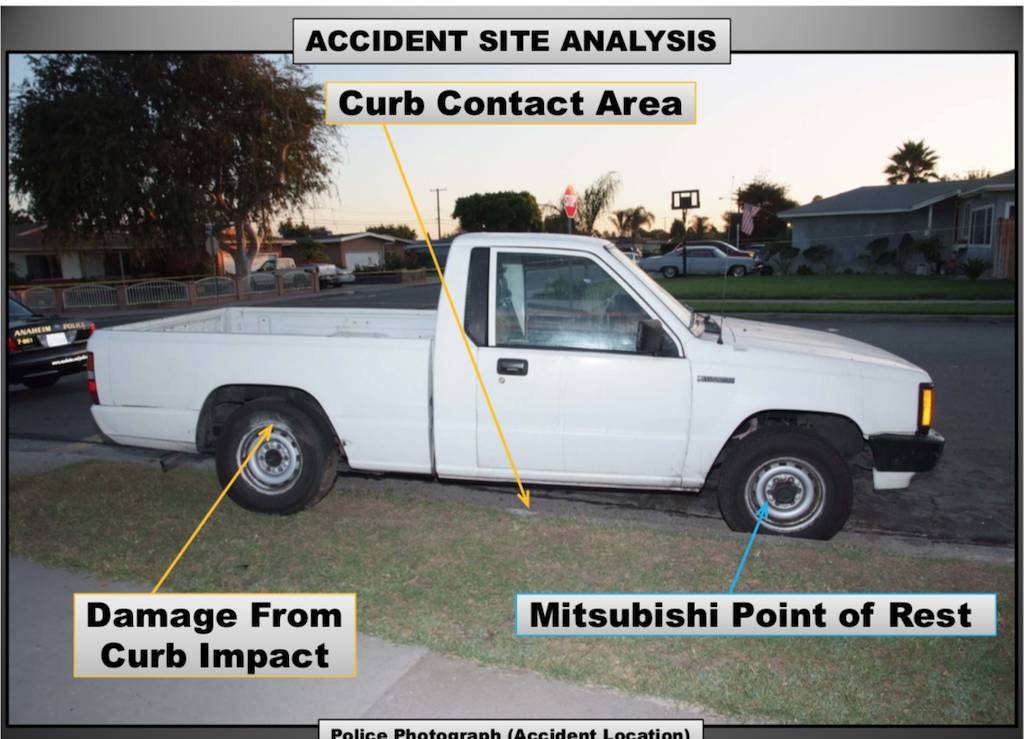
A demonstrative photo by Landerville showing the point of rest of the Mitsubishi pickup after Wyatt crashed the minivan into it. Photo courtesy of Anaheim City Attorney’s Office
I jumped out of the van and saw Matt approaching from the rear. I yelled at him that I had lost my gun and it was still in the van. My gun was later found under a pile of trash on the front passenger’s floorboard.
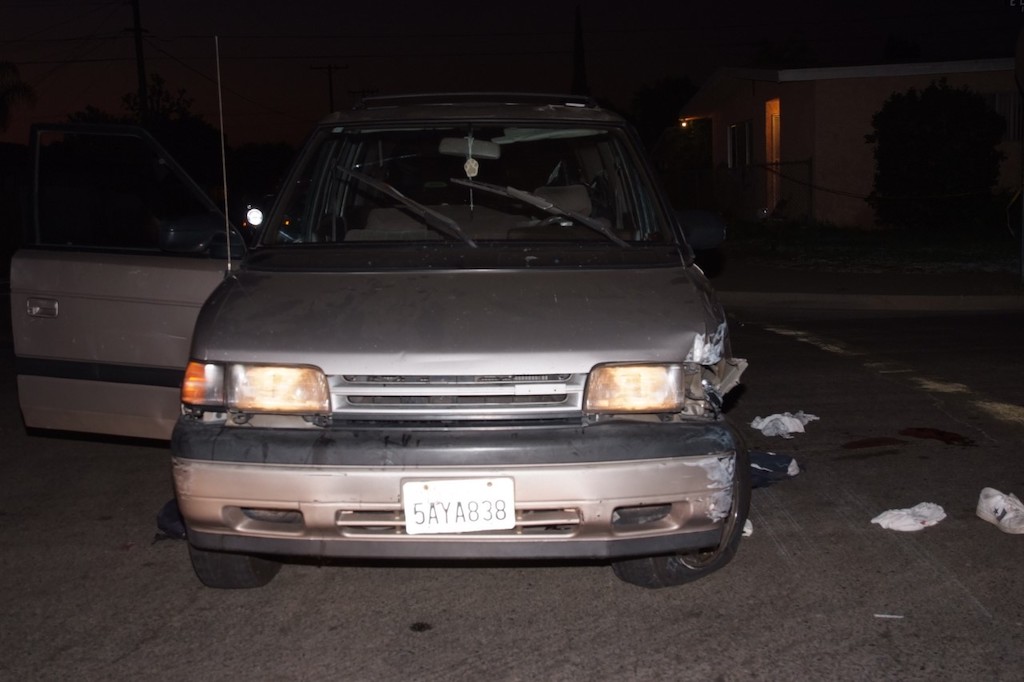
This photo shows the damage to the minivan after Wyatt crashed it to stop the van. Photo courtesy of Anaheim City Attorney’s Office
I had put out a 998 call (Officer Involved in a Shooting) over the radio and requested medics. The cavalry arrived and worked on the driver. When the scene was stabilized, I grabbed a cop and Matt and I walked him back to the start location to make sure the crime scene was secure. The bottle was still in the gutter and there was an acceleration skid mark in the street that would become very important in civil court.
I gave my public safety statement to a sergeant on scene and told him I knew the biggest question would be how and why I got in the van. I assured him that once that question was answered everything would make sense.
Over the next several hours we learned the driver was Adolph Anthony Sanchez Gonzalez, a 21-year-old armed and dangerous parolee at large. He was an active gang member, was in possession of a sales quantity of methamphetamine and indicia of drug sales, and there was a knife in the driver’s door pocket where he had been reaching.

This photo shows the scene looking northbound on Bond Street. The first intersection is Willow and the end of the street is the T intersection at Broadway. It was taken by the crime lab on the morning after the incident. Photo courtesy of Anaheim City Attorney’s Office
Matt gave his statement to the District Attorney’s Office that morning and I gave mine a few days later. Both Matt and I said the shot was fired either as the van passed through the intersection of Willow Street or just after it passed through that intersection. We also both said the fight lasted about 20 to 30 seconds and I shot Gonzalez within 5 to 10 seconds of the van driving off. This too became crucial in the civil case.
During the incident, I suffered a life-altering back injury that resulted in six spine surgeries and having to fight to retain full-duty status. I’ve had three spinal fusions, have a spinal cord stimulator implanted, and will take medication likely for the rest of my life.
But I survived.
The roller coaster begins
As is expected in fatal Officer Involved Shooting (OIS) cases, the decedent’s father filed a civil lawsuit. Shortly thereafter, the decedent’s mother and his daughter (who had not yet been born at the time of his death) joined suit and the cases were consolidated.
The plaintiff’s attorney was an LA based attorney , who has made a fortune suing cops and police departments in OIS cases. During my deposition in May 2011, plaintiff’s attorney asked me how far the van had traveled before I shot. I mistakenly answered that it was about 50 feet.
Here’s a lesson: I should have stayed with the landmark I was sure about, which was the intersection of Willow Street and not tried to estimate distance, because it was clearly wrong and was used to completely twist things around.
Here’s where that occurred.
The first lawsuit was filed in federal court in Los Angeles. I was represented by Assistant City Attorney Moses Johnson, a brilliant lawyer who is passionate about defending cops. Moses filed a Motion for Summary Judgment (MSJ), which was granted in July 2011.
In August 2011, the plaintiff’s attorney filed suit in state court. In May 2013, an appeal to the MSJ was heard by the 9th Circuit, and in a 2-1 decision, the MSJ was upheld.
In the opposition to the MSJ, the plaintiff’s attorney took my deposition statement and asserted that since I said the van had traveled 50 feet in 10 seconds before I shot, the van couldn’t have been going more than 3 to 7 miles per hour (mph), and therefore, I was never in imminent danger of death or serious bodily injury. The true distance was between 150-190 feet. One 9th Circuit Justice dissented and felt the distance and speed discrepancy created a triable issue of fact, but the majority upheld the MSJ.
In August 2013, the 4th District Court of Appeals dismissed the suit in state court, largely due to the 9th Circuit’s upholding of the MSJ. The Plaintiff allowed the 4th Circuit Court’s decision to become final, which legally should have ended the state suit once and for all.
Again, nothing in this case was easy.
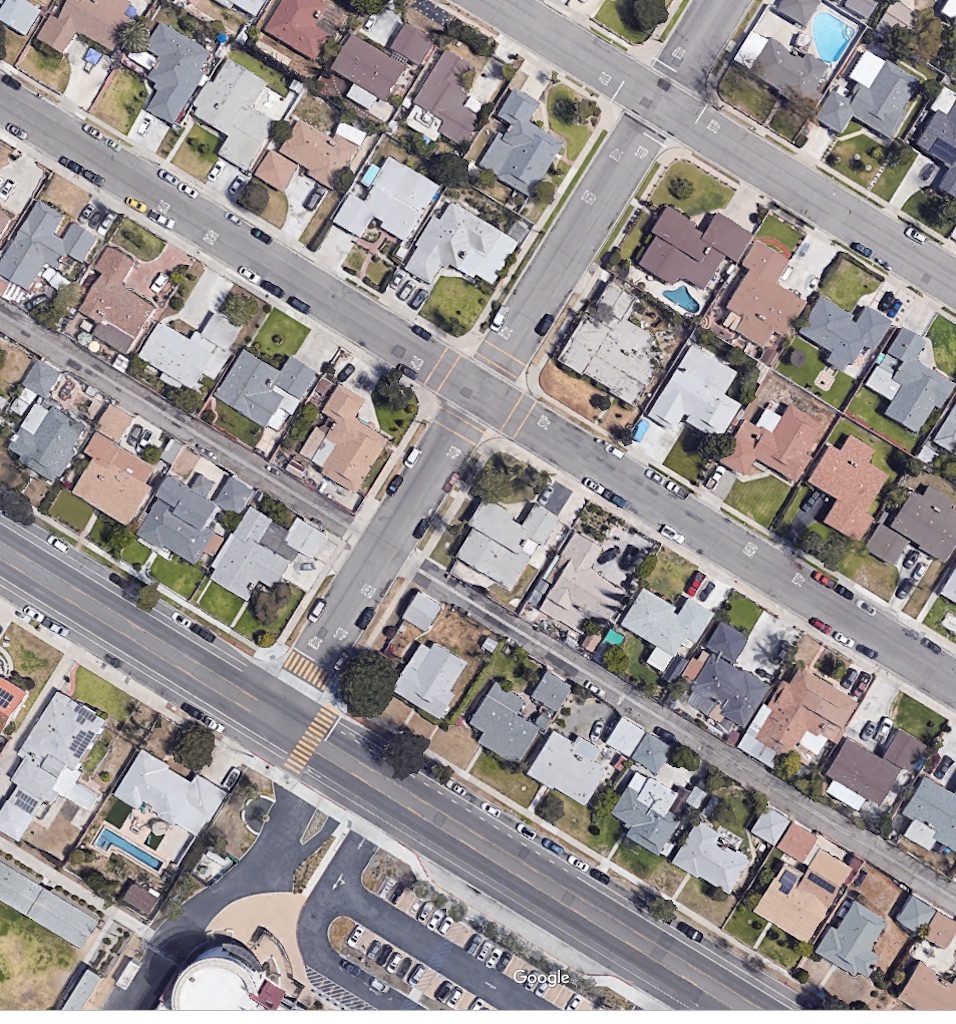
A Google Earth view of Bond Street between Santa Ana Street and Broadway. The total distance is approximately 750 feet.
In December 2013, in a rare and infrequent move, the 9th Circuit Court granted the Plaintiff an En Banc hearing before an 11-judge panel of the 9th Circuit.
During the initial phases of the hearing it sounded like the Court was heavily supportive of the MSJ, with four Justices arguing that all of my actions were reasonable under the circumstances and stating the Supreme Court forbade the Monday morning quarterbacking of rapidly unfolding events involving police officers.
But there was a palpable change when a justice suggested there were several other alternatives available to me including using a Taser and shooting the decedent someplace other than the head.
Ultimately, in March 2014, the En Banc panel of the 9th Circuit upheld all findings in the MSJ, except the deadly force, and ruled 7-4 that the issue as to whether or not my use of deadly force was excessive or unreasonable should be decided by a jury.
The majority quoted the Plaintiff’s discrepancy in the speed of the vehicle as something a jury could use to find the deadly force was unreasonable and excessive. A very strong dissenting opinion was authored by Judge Stephen Trott. Based on the prior rulings, the City decided to appeal the 9th Circuit’s En Banc reversal to the U.S. Supreme Court. Amicus briefs were filed supporting the City’s position by the International Municipal Lawyer’s Association and the California State Association of Counties. However, in November 2014, the U.S. Supreme Court declined to hear the case and sent it back to the District Court for trial.
Another critical piece of the puzzle was the California Supreme Court decision in 2013 in Hayes v County of San Diego, in which the court determined a police officers’ conduct and tactical considerations could be used in determining the reasonableness of deadly force.
Now, while the Hayes case had not been decided at the time this incident occurred, it could be applied because the civil litigation had not reached conclusion. That made no sense to me, but it was the law.
We all know that post-Hayes we train differently and those pre-shooting tactics are always at the forefront of our minds, but to be able to apply it retroactively? Come on.
As you can guess, the Plaintiff’s counsel would prefer to try the case in state court where he could argue negligence on my part for getting in the car. But the state case had already been dismissed and should have been done, right? Not so fast.
In April 2015, the Plaintiffs filed again in state court. The case was quickly dismissed, but was appealed to the 4th District Court of Appeal, the court that had upheld the dismissal two years earlier.
In late 2017, the case was argued in front of the 4th District Court. The Plaintiff’s counsel argued that because the District Court relied on the original 9th Circuit upholding the summary judgment and the En Banc panel had reversed, the 4th District Court should allow the State case to move forward.
The Plaintiff had never asked for a stay pending the En Banc and had allowed the judgment to become final, so as a matter of law, the case should have been done.
However, in another rare move, the 4th District Court of Appeal reinstated the case in State court.
California Evidence Code Section 352: Probative vs Prejudicial Evidence
On July 15, 2019, we appeared in Department C15 of the Orange County Superior Court for trial.
We began with Motions In Limine, in which the judge excluded Gonzalez’ criminal history, parole status, gang membership, toxicology, amount of narcotics found and the presence of the knife in the driver’s door panel.
The judge went so far as to rule that I couldn’t even talk about the tattoos I saw on Gonzalez’ knuckles, stating that the information was outweighed by its prejudicial nature. All of this was information I believed was important to the outcome. The trial was also bifurcated into two phases: Liability and Damages. If the jury found against us in the liability phase, we would then move to a damages phase, at which time some, but not all, of the bad stuff about the decedent would be allowed.
While I understand we did not have personal knowledge about all of that information at the time, it was all relevant and played into what happened that morning. Instead of us being able to argue that Gonzalez was a parolee at large who told his girlfriend he wasn’t going back to prison, the Plaintiff’s counsel was able to argue he was fleeing because we were using excessive force on him.
Instead of us being able to tell the jury he was under the influence of alcohol and methamphetamine, they were left to wonder.
Instead of us being able to talk about the sales quantity of meth, scale, and baggies found as he was out making dope deals, the jury was led to believe Gonzalez only had a very small amount of an unknown drug.
And instead of them knowing Gonzalez was an active gang member, the Plaintiff’s counsel was able to argue he was a “poor kid whose brains were blown out.”
We picked 16 jurors, including four alternates. The jury makeup was varied, nine men and seven women. There were two engineers, a couple of retirees, and four young students.
Testimony began with the Plaintiff’s counsel calling me as his first witness. I was on the stand for several hours over the course of two days. Having worked three tours in homicide, I was no stranger to the witness stand. My favorite part was when I was able to tell the jury that not only was I at risk of serious bodily injury, but that I had been seriously injured and had six spine surgeries. I had never been asked about injuries in my deposition, so it took the Plaintiff’s counsel completely by surprise.
Matt testified next and then we moved on to the Coroner and the Plaintiff’s police practices expert, who of course said that everything I did was wrong and it was all our fault. The Plaintiff rested after their expert testified.
Now it was our turn.
The most compelling testimony came from Jon Landerville, an engineer and accident reconstruction expert hired by Moses Johnson. Landerville reconstructed the collision between the van and the pickup truck and determined the minimum speed on impact was 30.4 mph. From there, he backtracked the events and determined the van was traveling at least 32.2 mph at the time I fired.
More importantly, with a constant rate of acceleration and without intervention, in just a few more seconds the van would have been at the T-intersection and traveling over 55 mph.
Landerville had even created a video reenactment to play for the jury. I have to admit, the video was so realistic, I felt like I was trapped in the car with Gonzalez all over again.
This video reconstruction by Jon Landerville shows the movement of the vehicle with Wyatt trapped inside. Courtesy of Anaheim City Attorney’s Office
The recreation determined my shot was fired at between 6 and 7 seconds after the van accelerated forward, the crash was at 9.9 seconds, and the entire event lasted about 13 seconds.
The defense rested on the afternoon of July 30. The next day was taken up by jury instructions and closing arguments. The Plaintiff’s counsel again suggested Gonzalez was just trying to get away from two cops who were unnecessarily beating him up, and while he may have made some mistakes, it “didn’t warrant the death penalty.”
He also said the entire series of events was driven by our actions, not the reverse, and that it was my negligence that sent the situation spiraling out of control, not Gonzalez’ refusal to comply.
Moses did a great job in his closing of explaining how the simple act of compliance at any stage of the contact would have resulted in a much different outcome, and it was Gonzalez’ actions that caused his own death.
On rebuttal, the Plaintiff’s counsel repeatedly called Gonzalez a “poor kid” and then told the jury there are way too many police shootings in America and that they should hold the police accountable.
I’d spent the past few nights reminding myself that I was alive because of my actions, and no matter what the jury decided, I knew I did the right thing. It went back to the old academy saying of, “I’d rather be tried by 12 than carried by six.”
I knew they couldn’t put me in jail; however, to think they could destroy my reputation on the eve of retirement after 33 years of working hard was deeply disturbing to me.
The jurors were supposed to return at 9:15 a.m. Thursday to begin deliberating At 9:30, the judge took the bench and informed us that a juror had called in sick and that he planned to release that juror and call in an alternate. He spun the wheel and an alternate juror was selected to come back.
By the time the alternate arrived and the jury went back to deliberate, it was just after 10:30 a.m. I left the courtroom with my wife and Matt, along with the Plaintiff’s counsel and his associate. In the hallway, the Plaintiff’s attorney thanked me for my professionalism throughout the case, told me he had no idea I had been seriously injured, and that he was sorry I was. I honestly believe he meant it.
He also said he knew it must have been hard for me to listen to him describe the events the way he did and talk about me in the manner he did and admitted he wouldn’t have liked it if it happened to him. I don’t think we will be sharing Thanksgiving dinners anytime soon, but his gesture was truly appreciated.
About 45 minutes later I got a text that read, “We have a verdict Please come back now.”
The jury had only been back there for about an hour. My heart was beating a mile a minute. I could barely breathe and my hands were shaking so bad I had to hold them together on the table.
The verdict
The jury came out and the Foreperson handed over a folder with the verdict form. I knew there were 9 or 10 questions on the verdict form and the form was several pages long. What questions got answered depended on the answers to prior questions. The judge took the folder and I watched as he started reading through all of the pages.
My heart sank. If it was a defense verdict, he should only have had to look at the first page. The judge asked the foreperson if the verdict form accurately represented their verdict and he said it did. The judge then took both attorneys back to the hallway. After a minute or two they returned to the counsel tables. Moses was stone-faced. The judge handed the folder to the court clerk and she read the verdict.
Question 1. Did Officer Daron Wyatt use excessive or unreasonable deadly force on Anthony Gonzalez?
Answer: No.
…
Question 4. Was Officer Daron Wyatt negligent?
Answer: No.
And with that we were done.
The only thing that could have been better was a unanimous decision, but the verdict was in our favor. The verdict was 10-2, with two jurors not agreeing with the rest.
Several jurors thanked Matt and I for our service. One alternate gave me and my wife a big hug and said they had prayed about the case all night long. They asked about Gonzalez’ toxicology and why we hadn’t shared it with them. When they were told the court excluded that and several other things from the liability phase, they felt they should have been told those pieces of information.
These jurors also said the two who were not with the majority believed that Gonzalez should have been given more time to comply, and that I should have shot him in the leg and not the head.
I gave Moses a big hug, and much to his dismay, a kiss on the cheek. I have a profound respect for Moses and was honored to have him represent me in what I am sure has been his longest legal battle.
Some other unsung heroes were my wife, Misty, who knew very little about the circumstances other than that I had been involved in a fatal shooting. She was in court every day except one when she was having a medical procedure herself. Moses’ Paralegal, Melissa Merrill, worked tirelessly in preparation for the trial and throughout the entire ordeal. She even ordered lunch for us daily. She is an absolute all-star.
And finally the countless prayer warriors. Friends from church, chaplains, co-workers, and friends of my parents who have known me for almost 50 years. I only asked for one prayer throughout: That the jury would see the truth. They evidently did.
For anyone who has ever been through something like this you know how unnerving it can be and how lonely the feeling is. The Department assigned Lt. Rod Duckwitz to sit through as the Department representative, and he was encouraging every step of the way, but I still felt as if my wife and I were alone on an island. Misty’s best friend’s husband sat with her at the beginning for support and I had a friend who came and sat in for a few hours at a time when he could.
Moses asked Duckwitz to ensure there was a show of support from the police department during closing arguments and for the next few days the gallery was a sea of blue. I cannot even begin to explain the emotional impact it had on me when I was able to look over my shoulder and see friends and coworkers there to show support. It meant the world.
The City’s Chief Communications Officer, Mike Lyster, was there from start to finish as much for me as part of his job.
I was a hard-working proactive cop up until the 9th Circuit’s En Banc reversal. After listening to the oral arguments and how some of the judges openly second guessed every move we made, even after being reminded the U.S. Supreme Court said they shouldn’t do so, it completely changed me. Before, I would see a good crook in the field, set target lock, and go get them. While enduring this nightmare, not so much.
But, in the end, the system worked. I don’t know that I will ever be able to police the same as I did before, but now I can rest easy in the knowledge that my name has been cleared and I can retire in peace.
 Behind the Badge
Behind the Badge
